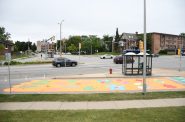Why Don’t Developers Build Larger Apartments?
All the city news you can use.
Every day at The Overhead Wire we sort through over 1,500 news items about cities and share the best ones with our email list. At the end of the week, we take some of the most popular stories and share them with Urban Milwaukee readers. They are national (or international) links, sometimes entertaining and sometimes absurd, but hopefully useful.
Importing small trucks from Japan: Japanese mini-trucks are being imported into the US by farmers and folks in rural areas that didn’t want to pay $80K for a truck that wouldn’t fit into a barn. Japan taxes vehicles by size and engine displacement annually which has led to a lot of these smaller work trucks and vans. They are still subject to the 25 year import rules, but have become a niche solution to an American problem of growing vehicle sizes. (Daniel Knowles | The Economist)
Why don’t we build larger apartments?: Millennials make up more than half the population increase in close in neighborhoods since 2010 but as they grow older and want more space, family sized units are harder to find. The housing shortage has highlighted the lack of affordable housing options in cities, but recently the discussion has also included why there aren’t enough units over two bedrooms. The answer is many regulatory barriers and high land costs. (Rachel M. Cohen | Vox)
Urban pandemic declines reversing: During the pandemic, there was a decline in population growth from reduced immigration and natural turnover. But large cities also saw big population outflows as fear of COVID-19 and proximity grew. New census data analyzed by demographer William Frey however shows that the population declines in cities might not have been permanent as many places that lost population are now seeing a massive reversal in growth. (William Frey | Brookings)
Reimagining alleys for drought, floods: Sunland, a neighborhood in Los Angeles would repeatedly flood after rain storms, clogging streets with debris and keeping people from getting to work and school. But a 2013 neighborhood retrofit that included a new green walkway, bioswales, and permeable pavement has reduced flooding, even during this winter’s massive storms. The project and others like it show how alleys and streets can be used to create a neighborhood benefit and reduce impacts from storms. (Erin Stone | LAist)
Quote of the Week
This was FDA’s effort to suggest that there’s not a concern about overall food sanitation and safety if you have a pet dog in an outdoor area. This isn’t FDA saying that restaurants ‘must’ do something or that they ‘cannot’ do something, because it still is the restaurant’s decision.
-Food and beverage lawyers Whitt Steineker in Axios on the FDA’s announcement that it’s ok to have pups dine with you outdoors at restaurants.
This week on the podcast, we’re joined by Andrew Jones, program director for the Uptown and Downtown Oakland Community Benefits District. We chat about urban place management, how urban spaces are taken care of, and what it takes to keep them vibrant and engaging.
Want more links to read? Visit The Overhead Wire and signup.
Urban Reads
-
Congestion Pricing Cuts Air Pollution in New York City
 Dec 14th, 2025 by Jeff Wood
Dec 14th, 2025 by Jeff Wood
-
We Think We Love to Drive. But Do We Really?
 Dec 7th, 2025 by Jeff Wood
Dec 7th, 2025 by Jeff Wood
-
Can Scott Wiener Tackle America’s Housing Crisis?
 Nov 23rd, 2025 by Jeff Wood
Nov 23rd, 2025 by Jeff Wood





















